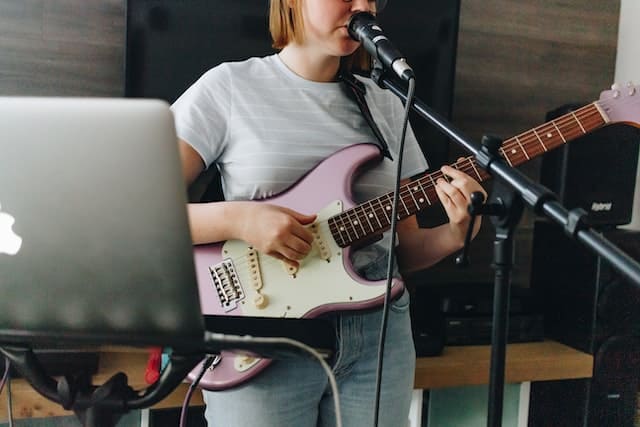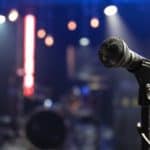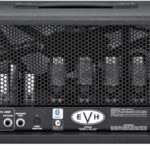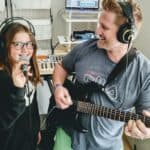As technology is evolving, many musicians are beginning to move away from traditional amplification and recording practices.
And companies always say that their products offer simple solutions to turn your home into a private recording studio.
But is it really that easy?
Connecting your guitar to a computer to use as an amp or for recording is pretty simple these days. You just need some type of interface/preamp, the correct cable, and nice headphones or speakers. The real challenge is deciding what DAW and amp simulation software you want to invest your money and time in.
Once you get everything set up and know what you’re doing it’s definitely convenient.
But expect to invest quite a bit of time installing, licensing, and learning to use the software that corresponds to the equipment.
Do you think you have what it takes to become your own sound engineer?
Here are some different ways you can start your journey.
1. Use a USB audio interface
Using a USB audio interface is the first choice for most people and you have likely seen a lot of these either in person or on the internet.
These act as a preamp for your instruments and microphones and I like to think of them as external sound cards for computers.
All of the ones that I have seen connect to the computer via a USB cable to transfer information and power the interfaces.
And you will probably get a free license for some entry-level audio software bundled with them.
I think the Focusrite Scarlett series is the most famous and they are priced pretty reasonably for the models with only a few inputs.
There are also USB mixers that would do the trick if you are used to that interface more.
And finally, the inputs on these interfaces should support instrument or line-in inputs.
So if you are more grounded in playing through traditional amplifiers, I would recommend running a “line out” signal from your amplifier to the interface rather than plugging directly in, especially for beginners.
2. Use a USB microphone
A USB microphone is an easy way to record acoustic guitar or vocals.
But you will probably have to experiment with the acoustic properties of the room you are playing in; it can make a huge difference.
I will also mention here that you can use an instrument microphone to “mic” your amplifier or speaker cabinet into an audio interface if you really want to capture your amp’s “to die for” tone.
And while USB microphones are usually designed for recording speech, with an audio interface you can use an instrument microphone like the famous Shure SM57.
3. Plug it straight into your PC’s mic input
It sounds easy, right?
Well, it is.
For this one, you would only need a 1/8 inch male to 1/4 inch female adapter.
Now, when you are connected, just make sure you have your recording device properly set up in Windows, or the OS you are using.
This will ensure the computer is taking the signal from the input you are sending it through.
4. Use a multi-effects processor
You can find many multi-effects processors that have the ability to interact with PCs via USB too.
Now you are losing the microphone option by going this route but if you only play guitar or bass then you can kill two birds with one stone with this combination of effects and interface.
And you can also use them to go directly into a PA system if you are planning to play live shows.
Some popular choices here are units such as the Boss GT-1000, Line 6 HX Stomp, Fractal Axe-FX III, and Kemper Profiler Stage Floorboard ($$$).
But if you are on a tight budget I suggest looking at some of the multi-effects units made by companies like Zoom.
5. Use an amp with a USB output
Some amplifiers with USB output jacks are much the same as using multi-effects processors.
These feed your signal out after the preamp but before the power amp of the amplifier, much the same as a line-out jack.
Back in the day, many PCs had sound cards with a line-in jack but I haven’t had a computer with one of those in over ten years.
So USB is the new line-in jack on computers I guess.
Some amp series that have this feature (not necessarily every amp in the series though) are the Boss Katana MkIIs, Yamaha THRs, Fender Mustangs, Peavey Vypyrs, Roland Blues Cubes, Blackstar ID Cores, and Positive Grid Sparks.
Using Your Computer As a Guitar Amp
Now if you want to skip using an amplifier for some reason, these days you can just use your computer instead.
One advantage of this is the huge variety of virtual amps, effects, and simulated cabinets that you can have access to in one small package.
It is also nice if you want to play at low volumes but of course, there are other ways of doing that.
But unfortunately connecting your instrument to your computer was just the beginning.
At this stage, you would preferably need to have some nice (powered) studio monitor speakers such as KRK ROKITs or at least some decent headphones.
However, playing guitar with headphones also works.
And just where do all of your virtual amplifiers come from?
Now it’s time to talk about some of the popular software options.
If you bought a USB recording interface you probably have some software prepackaged with it but some famous names to look for are Overloud’s TH-U, IK Multimedia’s Amplitube, Native Instruments’ Guitar Rig, and Positive Grid’s BIAS FX 2.
Some of these can be very expensive for the full versions so do some research before committing to one and be aware that some may be free to use for one amp model with many other amp models costing beaucoup moolah.
Luckily, there are some free alternatives out there, however, you won’t be getting all the perks of the premium ones mentioned above.
Youtube veteran Steve from Boston has a handy tutorial on using a PC as an amplifier here, and although it’s a few years old the core information has not changed significantly.
As for me, I’m perfectly happy with a traditional amplifier and I don’t foresee that changing anytime soon.
Recording Your Guitar with a Computer
If you want to record some of your songs to put them on Spotify, Youtube, or even TikTok, you will also need some software to do it.
This is probably the most difficult hurdle to jump if you are unfamiliar with such software because there are a lot of functions that you need to identify from very vague icons.
So I think it’s best to choose one DAW (Digital Audio Workstation) software and stick to it.
The Focusrite USB recording interfaces come with Ableton’s Live Lite and Tascam interfaces come packaged with Steinberg’s Cubase LE.
If you want something different and don’t mind spending some money I would suggest researching the more robust versions of those two as well as Avid’s Pro Tools (really popular), Propellerhead’s Reason, Presonus’ Studio One, and Image Line’s FL Studio (Fruity Loops).
Once you have your desired software suite installed and ready to go, it’s time to grab a cup of coffee and go through the tutorials to learn how to route your inputs and assign them to tracks, add reverb, etc.
I sometimes find independent software tutorials a little more entertaining and easy to follow.
And once you know your way around the DAW, the only thing left should be to put some new strings on your guitar and start recording.
Can You Use Your Guitar Effects and Pedals When Connecting to a Computer?
Whether you are using an interface, amp, or multi-effects pedal board you can still use your beloved pedals while connecting to your PC.
But I suggest you tread carefully as far as input levels are concerned.
Really pushing a tube amp and large speaker(s) may sound great but the same thing might clip your preamp on a USB interface if you have set your gain level according to the dry signal and then switch on something like a distortion effect.
Don’t worry, you’ll get the hang of it with experience.
Just do some trial runs to set all of your input levels before you actually hit the record button.
And remember you can always make adjustments within the DAW software too.
There are even ways to route effects such as reverb and delay through an interface as you would do with an effects loop on an amp, but that isn’t something I would recommend if you are just starting out.
Just relax; it’s not like you’re paying a recording studio by the hour.

Hello there, my name is Ramiro and I’ve been playing guitar for almost 20 years. I’m obsessed with everything gear-related and I thought it might be worth sharing it. From guitars, pedals, amps, and synths to studio gear and production tips, I hope you find what I post here useful, and I’ll try my best to keep it entertaining also.





